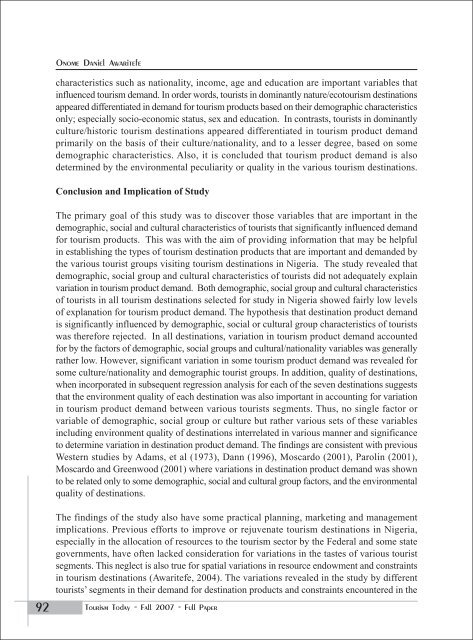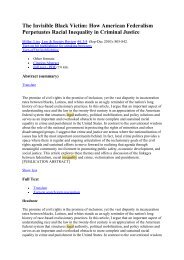Ski – resort and regional development: profile of visitors ... - E-Journal
Ski – resort and regional development: profile of visitors ... - E-Journal
Ski – resort and regional development: profile of visitors ... - E-Journal
You also want an ePaper? Increase the reach of your titles
YUMPU automatically turns print PDFs into web optimized ePapers that Google loves.
92<br />
Onome Daniel Awaritefe<br />
characteristics such as nationality, income, age <strong>and</strong> education are important variables that<br />
influenced tourism dem<strong>and</strong>. In order words, tourists in dominantly nature/ecotourism destinations<br />
appeared differentiated in dem<strong>and</strong> for tourism products based on their demographic characteristics<br />
only; especially socio-economic status, sex <strong>and</strong> education. In contrasts, tourists in dominantly<br />
culture/historic tourism destinations appeared differentiated in tourism product dem<strong>and</strong><br />
primarily on the basis <strong>of</strong> their culture/nationality, <strong>and</strong> to a lesser degree, based on some<br />
demographic characteristics. Also, it is concluded that tourism product dem<strong>and</strong> is also<br />
determined by the environmental peculiarity or quality in the various tourism destinations.<br />
Conclusion <strong>and</strong> Implication <strong>of</strong> Study<br />
The primary goal <strong>of</strong> this study was to discover those variables that are important in the<br />
demographic, social <strong>and</strong> cultural characteristics <strong>of</strong> tourists that significantly influenced dem<strong>and</strong><br />
for tourism products. This was with the aim <strong>of</strong> providing information that may be helpful<br />
in establishing the types <strong>of</strong> tourism destination products that are important <strong>and</strong> dem<strong>and</strong>ed by<br />
the various tourist groups visiting tourism destinations in Nigeria. The study revealed that<br />
demographic, social group <strong>and</strong> cultural characteristics <strong>of</strong> tourists did not adequately explain<br />
variation in tourism product dem<strong>and</strong>. Both demographic, social group <strong>and</strong> cultural characteristics<br />
<strong>of</strong> tourists in all tourism destinations selected for study in Nigeria showed fairly low levels<br />
<strong>of</strong> explanation for tourism product dem<strong>and</strong>. The hypothesis that destination product dem<strong>and</strong><br />
is significantly influenced by demographic, social or cultural group characteristics <strong>of</strong> tourists<br />
was therefore rejected. In all destinations, variation in tourism product dem<strong>and</strong> accounted<br />
for by the factors <strong>of</strong> demographic, social groups <strong>and</strong> cultural/nationality variables was generally<br />
rather low. However, significant variation in some tourism product dem<strong>and</strong> was revealed for<br />
some culture/nationality <strong>and</strong> demographic tourist groups. In addition, quality <strong>of</strong> destinations,<br />
when incorporated in subsequent regression analysis for each <strong>of</strong> the seven destinations suggests<br />
that the environment quality <strong>of</strong> each destination was also important in accounting for variation<br />
in tourism product dem<strong>and</strong> between various tourists segments. Thus, no single factor or<br />
variable <strong>of</strong> demographic, social group or culture but rather various sets <strong>of</strong> these variables<br />
including environment quality <strong>of</strong> destinations interrelated in various manner <strong>and</strong> significance<br />
to determine variation in destination product dem<strong>and</strong>. The findings are consistent with previous<br />
Western studies by Adams, et al (1973), Dann (1996), Moscardo (2001), Parolin (2001),<br />
Moscardo <strong>and</strong> Greenwood (2001) where variations in destination product dem<strong>and</strong> was shown<br />
to be related only to some demographic, social <strong>and</strong> cultural group factors, <strong>and</strong> the environmental<br />
quality <strong>of</strong> destinations.<br />
The findings <strong>of</strong> the study also have some practical planning, marketing <strong>and</strong> management<br />
implications. Previous efforts to improve or rejuvenate tourism destinations in Nigeria,<br />
especially in the allocation <strong>of</strong> resources to the tourism sector by the Federal <strong>and</strong> some state<br />
governments, have <strong>of</strong>ten lacked consideration for variations in the tastes <strong>of</strong> various tourist<br />
segments. This neglect is also true for spatial variations in resource endowment <strong>and</strong> constraints<br />
in tourism destinations (Awaritefe, 2004). The variations revealed in the study by different<br />
tourists’ segments in their dem<strong>and</strong> for destination products <strong>and</strong> constraints encountered in the<br />
Tourism Today - Fall 2007 - Full Paper














